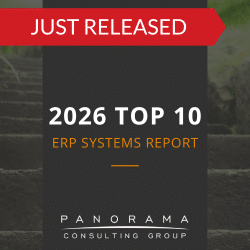Are you still working with clunky software and cumbersome spreadsheets? Chances are, you have many manual processes within your company that are slowing you down and causing pain points.
Before you automate manual business processes, it’s important to understand how to approach this effort strategically. Today, we’ll talk about the “why” behind process automation and share some general best practices for process improvement and ultimately, automation.
4 Benefits of Process Automation
1. Improve Employee Morale
By automating your business processes, you free up team members who would otherwise have been preoccupied with repetitive tasks.
Now, they have time to focus on more fulfilling work. In time, they’ll become more well-rounded employees.
Morale can drag when systems and workflows are slow, but the opposite happens when they are automated. Employees will be willing to accept higher positions and learn new skills.
The 2026 Top 10 ERP Systems Report
What vendors are you considering for your ERP implementation? This list is a helpful starting point.
2. Connectivity and Efficiency
With automation and the right cloud technology, employees can work from any device, at any time, as long as they have the proper connectivity. This makes them more flexible, efficient, and productive.
3. Reduce the Risk of Human Error
If your company is relying on manual-based workflows, employees are the ones handling your most important data entries and calculations. Even if they’re highly experienced and trained, the reality is that mistakes can happen, especially when there are multiple people working on the job at once.
Something as small as transposing one number can have detrimental consequences.
By automating business processes, you can reduce or even eliminate this vulnerability.
4. Make Smarter Business Decisions
Are you using your data to your advantage, mining it for insights that can help you make more informed decisions?
If not, then a business automation system, like an ERP or SCM system, can bring many benefits.
For example, you can leverage the power of artificial intelligence (AI) to improve your data management and analysis, providing users with customized dashboard views that show them real-time insights. These insights can be used to make data-driven business decisions.
How to Automate Manual Business Processes the Right Way
By taking the time to lay the groundwork early, you can set your team up for success when it comes to automating your business processes. Here are a few steps to help you get there.
1. Understand Roles and Responsibilities
We recommend creating standard operating procedures (SOP) documents for each process. Employees in each department can help create these SOPs, as they will have the closest working knowledge about their roles.
2. Explore Repetitive Tasks
Once you know the core functional areas you want to improve with automation, break it down even more. Think about which jobs within those areas are routine and repetitive.
To find repetitive tasks, start by reviewing the SOPs that your employees created.
3. Prioritize Key Areas
Start by prioritizing the functional areas where you might see the biggest operational improvements. For instance, which ones will have the greatest impact on your customers? Your workforce? Your overall business?
4. Consider Digital Transformation
To derive the most benefits from process automation, consider implementing enterprise systems as part of a digital transformation. Look for systems such as ERP, CRM, or SCM systems.
Learn More About Business Process Automation
When you automate manual business processes, you transform your company and allow employees to be as productive as possible. This improves morale, brand reputation, customer satisfaction, and your bottom line.
Interested in learning more about process automation? Contact one of our ERP consultants below to connect.














